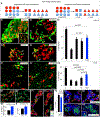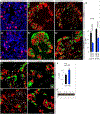Neurog3-Independent Methylation Is the Earliest Detectable Mark Distinguishing Pancreatic Progenitor Identity
- PMID: 30620902
- PMCID: PMC6327977
- DOI: 10.1016/j.devcel.2018.11.048
Neurog3-Independent Methylation Is the Earliest Detectable Mark Distinguishing Pancreatic Progenitor Identity
Abstract
In the developing pancreas, transient Neurog3-expressing progenitors give rise to four major islet cell types: α, β, δ, and γ; when and how the Neurog3+ cells choose cell fate is unknown. Using single-cell RNA-seq, trajectory analysis, and combinatorial lineage tracing, we showed here that the Neurog3+ cells co-expressing Myt1 (i.e., Myt1+Neurog3+) were biased toward β cell fate, while those not simultaneously expressing Myt1 (Myt1-Neurog3+) favored α fate. Myt1 manipulation only marginally affected α versus β cell specification, suggesting Myt1 as a marker but not determinant for islet-cell-type specification. The Myt1+Neurog3+ cells displayed higher Dnmt1 expression and enhancer methylation at Arx, an α-fate-promoting gene. Inhibiting Dnmts in pancreatic progenitors promoted α cell specification, while Dnmt1 overexpression or Arx enhancer hypermethylation favored β cell production. Moreover, the pancreatic progenitors contained distinct Arx enhancer methylation states without transcriptionally definable sub-populations, a phenotype independent of Neurog3 activity. These data suggest that Neurog3-independent methylation on fate-determining gene enhancers specifies distinct endocrine-cell programs.
Keywords: Arx; DMR; DNA methylation; DNMT; HMR; Myt1; azacytidine; combinatorial lineage tracing; diabetes; epigenetics; glucagon; insulin; lineage priming; p-Creode; pseudotime; single-cell RNA-seq; specification; stochastic gene expression; trajectory; transcriptional noise; α cell; β cell.
Published by Elsevier Inc.
Conflict of interest statement
Declarations of Interests:
The authors declare no competing interests.
Figures







Similar articles
-
Rfx6 is an Ngn3-dependent winged helix transcription factor required for pancreatic islet cell development.Development. 2010 Jan;137(2):203-12. doi: 10.1242/dev.041673. Development. 2010. PMID: 20040487 Free PMC article.
-
Regulation of Neurod1 contributes to the lineage potential of Neurogenin3+ endocrine precursor cells in the pancreas.PLoS Genet. 2013;9(2):e1003278. doi: 10.1371/journal.pgen.1003278. Epub 2013 Feb 7. PLoS Genet. 2013. PMID: 23408910 Free PMC article.
-
The homeodomain-containing transcription factors Arx and Pax4 control enteroendocrine subtype specification in mice.PLoS One. 2012;7(5):e36449. doi: 10.1371/journal.pone.0036449. Epub 2012 May 3. PLoS One. 2012. PMID: 22570716 Free PMC article.
-
Revisiting the immunocytochemical detection of Neurogenin 3 expression in mouse and man.Diabetes Obes Metab. 2016 Sep;18 Suppl 1:10-22. doi: 10.1111/dom.12718. Diabetes Obes Metab. 2016. PMID: 27615127 Review.
-
Islet cell development.Adv Exp Med Biol. 2010;654:59-75. doi: 10.1007/978-90-481-3271-3_4. Adv Exp Med Biol. 2010. PMID: 20217494 Review.
Cited by
-
Lineage tracing: technology tool for exploring the development, regeneration, and disease of the digestive system.Stem Cell Res Ther. 2020 Oct 15;11(1):438. doi: 10.1186/s13287-020-01941-y. Stem Cell Res Ther. 2020. PMID: 33059752 Free PMC article. Review.
-
Stem Cells in the Exocrine Pancreas during Homeostasis, Injury, and Cancer.Cancers (Basel). 2021 Jun 30;13(13):3295. doi: 10.3390/cancers13133295. Cancers (Basel). 2021. PMID: 34209288 Free PMC article. Review.
-
Pancreatic development: one cell at a (pseudo)time.EMBO J. 2019 Apr 15;38(8):e101891. doi: 10.15252/embj.2019101891. Epub 2019 Mar 26. EMBO J. 2019. PMID: 30914428 Free PMC article.
-
NEUROD1 Is Required for the Early α and β Endocrine Differentiation in the Pancreas.Int J Mol Sci. 2021 Jun 23;22(13):6713. doi: 10.3390/ijms22136713. Int J Mol Sci. 2021. PMID: 34201511 Free PMC article.
-
Epigenetics and Type 2 Diabetes Risk.Curr Diab Rep. 2019 Jun 27;19(8):47. doi: 10.1007/s11892-019-1168-8. Curr Diab Rep. 2019. PMID: 31250127 Free PMC article. Review.
References
-
- Bastidas-Ponce A, Scheibner K, Lickert H, and Bakhti M (2017). Cellular and molecular mechanisms coordinating pancreas development. Development 144, 2873–2888. - PubMed
Publication types
MeSH terms
Substances
Grants and funding
- T32 HD007502/HD/NICHD NIH HHS/United States
- P50 CA095103/CA/NCI NIH HHS/United States
- U54 MD007586/MD/NIMHD NIH HHS/United States
- P30 DK058404/DK/NIDDK NIH HHS/United States
- R01 DK106228/DK/NIDDK NIH HHS/United States
- U2C DK059637/DK/NIDDK NIH HHS/United States
- R01 DK065949/DK/NIDDK NIH HHS/United States
- P30 EY008126/EY/NEI NIH HHS/United States
- P30 DK020593/DK/NIDDK NIH HHS/United States
- P30 CA068485/CA/NCI NIH HHS/United States
- F31 GM120940/GM/NIGMS NIH HHS/United States
- R01 DK103831/DK/NIDDK NIH HHS/United States
- U24 DK059637/DK/NIDDK NIH HHS/United States
- R01 DK125696/DK/NIDDK NIH HHS/United States
LinkOut - more resources
Full Text Sources
Molecular Biology Databases
Research Materials

